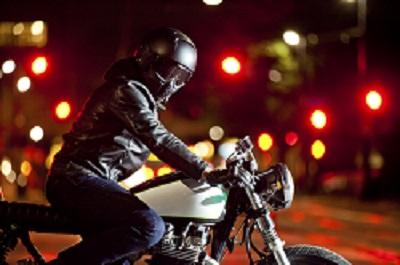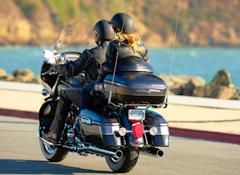

Some of the lessons we were taught at a young age have a way of staying with us as adults. Take sharing, for example.
We encourage children to share their toys, share with their class, and share lessons learned. As they get older, they learn there are exceptions to the sharing rule—like toothbrushes, passwords, and account information. While the rules of sharing are not always clear, they are a little clearer when it comes to sharing the road with motorcycles.
Here are some ways to exhibit “sharing is caring” while on the road:
Lane etiquette. Motorcycles have rightful and full use of traffic lanes, the same as cars and trucks. Do not try to share lanes with motorcycles. (That kind of sharing is bad.)
Mirror, mirror. Check your blind spots and be extra cautious when merging or changing lanes. Motorcycles are small and may blend into other images in your mirrors, veer in and out of blind spots, and be faster than they appear. Also, make sure your vehicle’s side-view mirrors are set correctly.
Four is more. When a motorcycle is traveling in front of your vehicle, allow more distance behind them than you would a car or truck. Apply the 4-second rule instead of the 2-second rule.
Pass with care. If you are going to pass a motorcycle, be mindful that the gust of wind created from your vehicle’s increased speed could cause the motorcycle to become unstable and result in a serious accident. As always, use your vehicle’s turn signal to alert other drivers of your intent to pass, and move several car lengths ahead of the vehicle before returning to your lane.
Taking turns. (Another childhood lesson.) Be aware that a motorcycle’s turn signal may not automatically cancel after a turn, since this wasn’t a standard feature for cycles manufactured prior to the 80s. If a cycle’s turn signal is on, it doesn’t necessarily mean it is going to turn—it may still be on from a previous turn. Use extra caution when turning left in front of a motorcycle. If unsure of the motorcycle’s intention, wait to turn until the motorcycle has passed.
Motorcyclists are more likely to be injured and injured seriously due to the lack of safety features and protections found in cars and trucks (airbags, seat belts, doors). Weather conditions pose driving challenges for all drivers, but they can be more treacherous for motorcyclists, particularly wind. Look out for motorcycles. Follow the rules of the road and follow these tips for sharing the road with motorcycles.
======================
Motorcyclist deaths occurred 27 times more frequently than fatalities in other vehicles, based on 2014 fatal crash data. To keep motorcyclists safe, we urge everyone to share the road and be alert, and we're reminding motorcyclists to make themselves visible, to use DOT-compliant motorcycle helmets, and to always ride sober.
HE TOPIC
Safe riding practices and cooperation from all road users will help reduce the number of fatalities and injuries on our nation’s highways. But it’s especially important for motorists to understand the safety challenges faced by motorcyclists such as size and visibility, and motorcycle riding practices like downshifting and weaving to know how to anticipate and respond to them. By raising motorists’ awareness, both drivers and riders will be safer sharing the road.
THE TOPIC
If you ride a motorcycle, you already know how much fun riding can be. You understand the exhilaration of cruising the open road and the challenge of controlling a motorcycle. But motorcycling also can be dangerous. The latest vehicle mile travel data show motorcyclists are about 27 times as likely as passenger car occupants to die in a motor vehicle traffic crash and 6 times as likely to be injured. Safe motorcycling takes balance, coordination, and good judgment. Here are some ways to ensure that you'll be around to enjoy riding your motorcycle for many years to come.
Driving a car and riding a motorcycle require different skills and knowledge. Although motorcycle-licensing regulations vary, all States require a motorcycle license endorsement to supplement your automobile driver's license. To receive the proper endorsement in most states, you'll need to pass written and on-cycle skills tests administered by your State's licensing agency.
Some States require you to take a State-sponsored rider education course. Others waive the on-cycle skills test if you've already taken and passed a State-approved course. Either way, completing a motorcycle rider education course is a good way to ensure you have the correct instruction and experience it takes to ride a motorcycle. For the motorcycle rider-training course nearest you, call the Motorcycle Safety Foundation at (800) 446-9227.
Given the fact that motorcycles vary in handling and responsiveness, be sure to take the time to get accustomed to the feel of a new or unfamiliar motorcycle by riding it in a controlled area. Once you feel comfortable with your bike, you can take it into traffic. Make sure you know how to handle your motorcycle in a variety of conditions (e.g., inclement weather or encountering hazards such as slick roads, potholes, and road debris). If you plan to carry cargo or a passenger, be prepared to make adjustments to the tires, suspension, and placement of the load.
Before every ride, you should check the tire pressure and tread depth, hand and foot brakes, headlights and signal indicators, and fluid levels. You should also check under the motorcycle for signs of oil or gas leaks. If you're carrying cargo, you should secure and balance the load on the cycle; and adjust the suspension and tire pressure to accommodate the extra weight.
If you're carrying a passenger, he or she should mount the motorcycle only after the engine has started; should sit as far forward as possible, directly behind you; and should keep both feet on the foot rests at all times, even when the motorcycle is stopped. Remind your passenger to keep his or her legs and feet away from the muffler. Tell your passenger to hold on firmly to your waist, hips, or belt; keep movement to a minimum; and lean at the same time and in the same direction as you do. Do not let your passenger dismount the motorcycle until you say it is safe.
THE TOPIC
If you're ever in a serious motorcycle crash, the best hope you have for protecting your brain is a motorcycle helmet. Always wear a helmet meeting the U.S. Department of Transportation (DOT) Federal Motor Vehicle Safety Standard (FMVSS) 218. Look for the DOT symbol on the outside back of the helmet. That is the manufacturer's way of certifying the helmet meets the DOT standard. A certified helmet also will have a permanent inside label identifying the manufacturer and providing information about the care and use of the helmet. Helmets meeting FMVSS 218 weigh around three pounds; have a thick polystyrene-foam lining; and sturdy chinstraps. ANSI or Snell labels are voluntary indicators of helmet quality. Don't leave your helmet behind on short trips because it could be a deadly mistake. Some motorcycle helmets, in addition to offering protection to your head in a crash, include plastic face shields that offer protection from wind, rain, insects, dust, and stones thrown up from cars. If your helmet doesn't have a face shield, be sure you wear goggles because eyeglasses won't keep your eyes from watering, and can easily fall off.
Arms and legs should be completely covered when riding a motorcycle, ideally by wearing leather or heavy denim. In addition to providing protection in a crash, protective gear also helps prevent dehydration. Boots or shoes should be high enough to cover your ankles, while gloves allow for a better grip and help protect your hands in the event of a crash. Wearing brightly colored clothing with reflective material will make you more visible to other vehicle drivers.
Experienced riders know local traffic laws - and they don't take risks. Obey traffic lights, signs, speed limits, and lane markings; ride with the flow of traffic and leave plenty of room between your bike and other vehicles; and always check behind you and signal before you change lanes. Remember to ride defensively. The majority of multi-vehicle motorcycle crashes generally are caused when other drivers simply didn't see the motorcyclist. Proceed cautiously at intersections and yield to pedestrians and other vehicles as appropriate. You can increase your visibility by applying reflective materials to your motorcycle and by keeping your motorcycle's headlights on at all times, even using high beams during the day.
Alcohol and drugs, including some prescribed medications, negatively affect your judgment, coordination, balance, throttle control, and ability to shift gears. These substances also impair your alertness and reduce your reaction time. Even when you're fully alert, it's impossible to predict what other vehicles or pedestrians are going to do. Therefore, make sure you are alcohol and drug free when you get on your motorcycle. Otherwise, you'll be heading for trouble
==================
When spring is in the air, motorcycles are everywhere. Do you long for the freedom that comes with riding on the open road? Then it's critical to respect your machine and improve your skills throughout your lifetime.
But that's only half the story. Motorists interested only in four-wheeled vehicles still have a major responsibility in keeping motorcyclists safe on the road.
In recognition of National Motorcycle Safety Awareness Month in May, the National Safety Council reminds riders – and drivers – to do their part.
In 2016, 4,976 motorcycle riders and passengers died in crashes, and nonfatal injuries that year totaled 88,000, according to Injury Facts® 2017, the statistical compendium on unintentional deaths and injuries published by NSC. Fatalities among motorcycle riders and passengers have increased nearly 3% from 2006, driven largely by an 8% increase in 2015.
The vast majority of vehicles on the road are not motorcycles. They're cars and vans and trucks. It's quite possible that as a driver you rarely think about motorcycles.
This is a problem.
"When motorcycles and other vehicles collide,it is usually the other (non-motorcycle) driver who violates the motorcyclist's right of way," according to an issue statement from NHTSA. "There is a continuing need to help other motorists 'think' motorcycles and to educate motorcyclists to be aware of this problem."
Why do drivers often violate motorcyclists' right of way?
Driver education programs should emphasize these issues – especially in programs for mature drivers who may have diminished abilities.
Riders 50 and older made up 36% of all motorcycle fatalities in 2016, according to the Insurance Institute for Highway Safety. So-called "re-entry riders," who rode in their 20s and decided to take it up again in their late 40s to 60s face additional challenges today: more traffic, more powerful bikes, more distracted drivers and diminished physical skills.
If you're going to ride a motorcycle, it's important to commit to a lifetime of learning new skills and brushing up on the old ones.
Read about Baby Boomers and motorcycle safety concerns.
A helmet is the most important equipment a biker can use. In 2016, 1,876 motorcyclists who died were not wearing a helmet.
Helmets are estimated to be 37% effective in preventing fatal injuries for operators and 41% for passengers, according to Injury Facts® 2017.
Not every state has a helmet law, but even if yours doesn't, wear one anyway. A motorcycle crash is a "violent event." More than 80% of all reported motorcycle crashes result in injury or death, according to NHTSA. In addition to wearing a helmet: